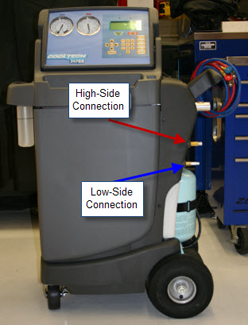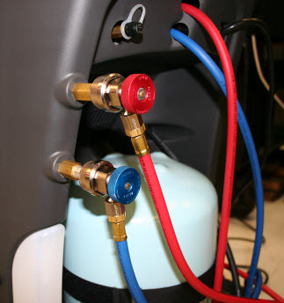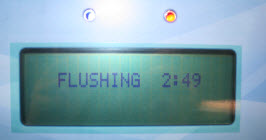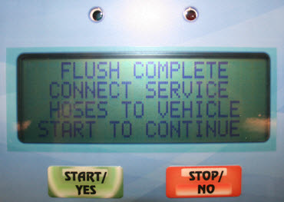Tesla Model S: Set Up HVAC Machine
Warning: Servicing must only be performed by personnel familiar with both vehicle systems and the charging and testing equipment. Always read and understand the HVAC machine operator's manual before operating the HVAC machine.
Warning: R134a and R1234yf are hazardous liquids and, if handled incorrectly, can cause serious injury. Suitable protective clothing, consisting of face protection, heat-proof gloves, rubber boots and apron or waterproof overalls, must be worn when carrying out operations on the air conditioning system.
Warning: Do not breathe refrigerant and lubricant vapor or mist. Exposure may cause personal injury, especially to the eyes, nose, throat, and lungs. Perform service and repairs in a well-ventilated area. If accidental discharge occurs, ventilate the work area before returning to work. Additional health and safety information may be obtained from equipment, refrigerant and lubricant manufacturers; refer to their instruction manuals and Material Safety Data Sheets.
Warning: Avoid using an extension cord on the recovery machine whenever possible. If an extension cord is used, it may overheat and cause a fire. If you must use an extension cord, use the shortest extension cord possible with a minimum 14AWG wire rating.
Warning: Do not use compressed air to pressure test or leak test the HVAC machine or the vehicle HVAC system. Some mixtures of air and refrigerant are combustible at elevated pressures. These mixtures are potentially dangerous and may result in fire or explosion, causing personal injury or property damage.
Warning: Be aware of fire hazards. Do not use the HVAC machine in the vicinity of spilled or open containers of flammable liquid.
Warning: If you are operating the HVAC machine in an environment where temperatures exceed 120 degrees Fahrenheit/49 degrees Celsius, you must wait 10 minutes between jobs.
Warning: Never transfer refrigerants to a cylinder or tank unless it is Department of Transportation approved for refilling. DOT approval is indicated by the designation "DOT 4BA" or "DOT 4BW" stamped on a tank's collar (handle). If a refrigerant tank is overfilled, it may explode. To prevent this from occurring, when transferring refrigerant into a tank, the safe filling level must be controlled by weight, and must not exceed 60% of the tank's gross weight rating.
Caution: Only use Tesla-specified refrigerant in the vehicle and the A/C recovery and recharge machine. The unit is designed to recover, recycle, and recharge only Tesla-specified refrigerant. Do not attempt to adapt the unit for another refrigerant. Do not mix refrigerant types through a system or in the same container; mixing of refrigerants will cause severe damage to the unit and the vehicle air conditioning system.
Caution: Do not mix different types of A/C system oil. Model S and Model X use ND-11 spec POE oil, while Roadster 1.5 and 2.0 use different oils (PVE for 1.5 cars and POE for 2.0/2.5 cars). Perform internal self-flushing of the A/C lines in the machine before and after every service to prevent cross-contamination when servicing different vehicles. Refer to the section "Set Up HVAC Machine" for further information on performing the self-flushing procedure of the A/C lines.
Caution: Do not allow refrigerant oil to come in contact with any surfaces of the vehicle as it may cause damage to the paint, trim, or finish on the vehicle.
Caution: Always keep refrigerant oil tightly sealed, clearly marked, and in its original container to prevent contamination of any kind.
Caution: Do not over-fill the vehicle's A/C system with oil. Only put in the exact amount that you take out. Always measure the amount of oil extracted and refill it with that exact amount.
Caution: Always maintain different oil canisters for managing different types of oil. These canisters should be clearly marked to avoid any cross-contamination when switching between the two oils.
Caution: The refrigerant cylinders currently in use as source tanks are disposable cylinders. Before they are discarded, disposable refrigerant cylinders should be connected to recovery equipment and brought to a vacuum to ensure that all refrigerant has been removed. The cylinder should then be marked "Empty".
Caution: Always follow the information label when determining the refrigerant capacity of the vehicle being worked on. Do not over-fill or under-fill the air conditioning system with refrigerant. Set Up HVAC Machine
Note: These preparation steps must be performed before any diagnosis and repair procedures.
- Perform a calibration check of the HVAC machine. Refer to the HVAC machine operator's manual for instructions on how to perform a calibration check of the HVAC machine. If a machine fails the calibration check, do not perform the service until a service representative calibrates the HVAC machine.
- Check the full length of the service lines and service ports for damage or degradation. Ensure that there are no obvious signs of damage or degradation that could cause a leak when servicing the vehicle.
- Check the HVAC machine's power supply cord before servicing the vehicle. Ensure it is not damaged and the insulation has not been compromised in any way.
- Verify that the oil type is ND-11 spec POE.
Warning: Servicing must only be carried out by personnel familiar with both the vehicle system and the charging and testing equipment. All operations must be carried out in a well-ventilated area away from open flame and heat sources. Warning: Air conditioning refrigerant is a hazardous liquid and if handled incorrectly can cause serious injury. Suitable protective clothing, consisting of face protection, heat-proof gloves, rubber boots and apron or waterproof overalls, must be worn when carrying out operations on the air conditioning system.
In order to prevent cross-contamination of refrigerant oils in the HVAC system, it is necessary to flush the HVAC machine hoses before and after every HVAC service. The remaining steps in this section explain how to flush the hoses of the Robinair Model 34788z machine.
- Press the MENU button on the keypad.
- Press the UP or DOWN arrow key to scroll to "HOSE FLUSH". Press START/YES.
- Connect the hoses to the unit's storage storage port connections
on the right side of the unit.

- Open the coupler valves.

- Press START/YES to begin the hose flush
process. If the procedure has started correctly, a three minute
countdown begins. The machine automatically starts and finishes the
recovery from the hoses after the flush procedure is completed.

- When the entire procedure has been completed, the screen
displays "FLUSH COMPLETE CONNECT SERVICE HOSES TO VEHICLE, START TO
CONTINUE".

- Close the coupler valves and press START/YES.
- Press STOP/NO to exit the hose flush menu.
- Connect the appropriate refrigerant oil bottle.

